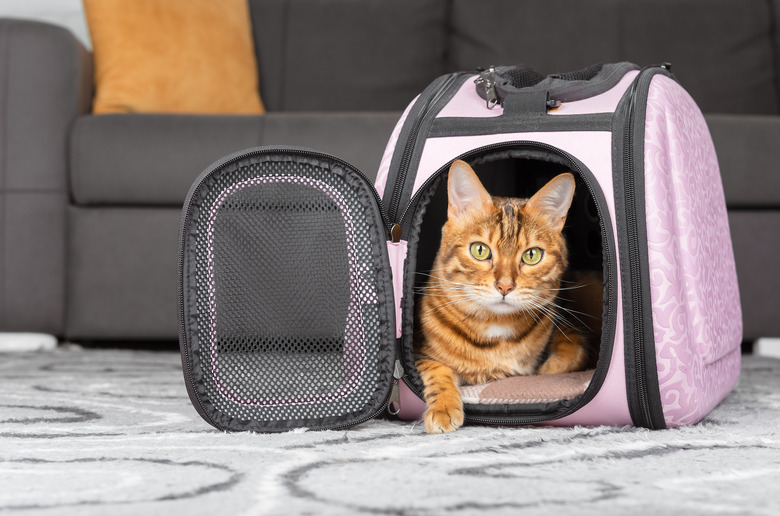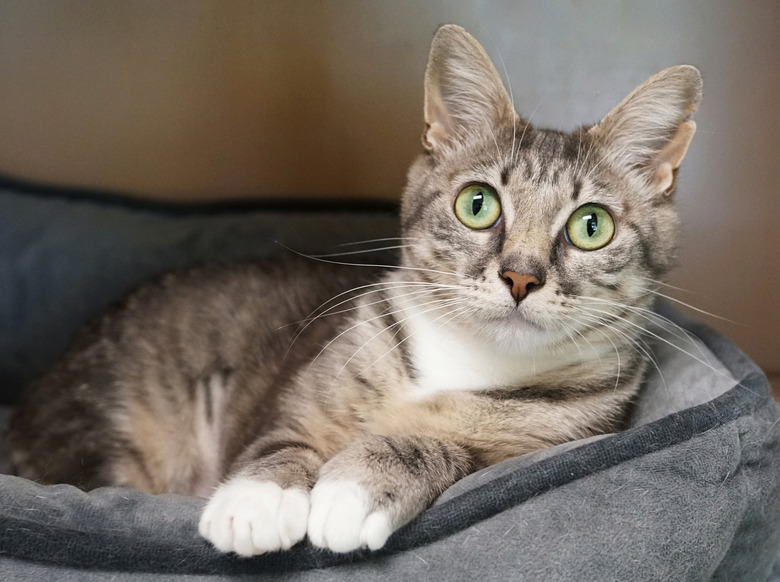10 Ways To Get Your Home Ready For An Adopted Cat
Cat adoption is exciting, but you may feel a little bit nervous about how to prepare. Adult cats and senior cats can be quite territorial. They may become stressed in new surroundings and a new environment. Kittens are curious and mischievous. Here is your guide to making your new feline family member feel secure and welcome.
1. Create a safe space for your new adopted cat
1.
Create a safe space for your new adopted cat
Provide a quiet, safe room with hiding places and a designated cat space. Only give them access to other areas as they become more secure — usually after the first week. Cats feel happier when they can get up high, so place cozy cat beds and resting areas at different levels. You can do this by using a cat tree or shelves.
Leave a small blanket with them at their current home and then place it in their new bed in your home. The familiar scent will help reduce their stress levels.
2. Purchase food and water bowls for your new cat
2. Purchase food and water bowls for your new cat
Buy separate water bowls and food bowls that are difficult to tip over and easy to clean. Place food and water bowls away from each other as this will encourage drinking.
Create multiple feeding and watering stations to reduce competition if you will have more than one cat. Change the water in the bowl at least once daily.
Ask the shelter what the cat is already eating and keep them on this wet cat food and dry food during the transition period. If you plan to switch foods eventually, let the cat settle in first. Then slowly and gradually introduce your new cat to their new food.
3. Make or buy cat toys and interactive toys
3. Make or buy cat toys and interactive toys
Play and exploration keep cats and kittens mentally and physically healthy. A simple homemade toy such as a scrunched-up paper ball, toilet paper tube, or cardboard box will give them joy — just as much as an expensive store-bought toy.
Safety is most important when creating or purchasing toys. so ensure that small items or toys with strings are put away when you are not supervising. In particular, laser pointers can lead to injuries and frustration for your cat — and should not be used.
However, food enrichment toys and hiding their food in different places are mentally and physically stimulating for cats.
4. Provide scratching posts for your adopted cat
4. Provide scratching posts for your adopted cat
Cats need to scratch. By providing a couple of vertical scratching posts along with something to coax them, such as catnip, you will help them learn what they are allowed to scratch.
5. Choose a litter box and litter for your new cat
5.
Choose a litter box and litter for your new
cat
At least two large open litter trays will help your cat develop good litter box habits. Place them in quiet areas and add an extra tray for each additional cat or kitten.
Ask which litter they are currently using and continue using that litter. Otherwise, most cats are happy with fine, clumping litter. Litter boxes and cat litter must be cleaned at least once daily.
6. Purchase a cat carrier to safely transport your new cat
6.
Purchase a cat carrier to safely transport your
new cat
You will need a well-ventilated, sturdy, and secure cat carrier to bring your new cat home. You will also need it for transporting your cat to future veterinarian visits for your cat's checkups, vaccinations, spaying and neutering surgery. If you decide to travel with your cat, a carrier will be necessary on trips to keep them safe.
7. Buy grooming equipment for cats and kittens
7. Buy grooming equipment for cats and kittens
Find a brush suitable for your new cat's coat type, as daily grooming is essential for their health and for relationship building. Purchasing and learning to use cat nail clippers will help reduce damage to furniture from cat scratching and clawing. Clipping your cat's nails will also prevent you from having accidental scratching injuries.
8. Cat-proof your home
8. Cat-proof your home
Your new cat or kitten will check out every nook and cranny of your home as their confidence grows. They are likely to bite, chew, and knock over things they find along the way. Top heavy furniture that might topple when a curious cat jumps up to investigate, such as a TV that isn't bolted to the wall, needs to be anchored. Climbing and jumping are normal parts of a cat's personality and their need to explore.
Remove household plants, breakable planters, or other objects until your cat or kitten has settled in. Many common houseplants are dangerous to cats. Even non-toxic plants may be played with, chewed, dug up, pooped in, or tipped over by them.
Unplug electrical items when they are not in use. You should also consider getting covers for electrical cords around your home. Put other hazardous items, such as blind cords, out of harm's way. Safely lock away potentially dangerous substances such as medicines and household cleaning products.
One of the biggest risks if you have a new cat, especially one that has always lived indoors, is escaping. If you will be opening windows, check that they have well-fitting screens or protectors to prevent your cat from getting away or falling out if you live on an upper floor. Make sure that all household members understand how important it is to take care when opening doors, in case the new cat gets frightened and slips out.
9. Introduce your new cat to people and pets over time
9. Introduce your new cat to people and pets over time
Cats are naturally very sensitive to change. Something as simple as new smells can make them anxious, so limit the number of visitors you have in the early days. This will allow them to become comfortable and understand that they are safe in their new home. Do not force your adopted cat to meet guests. Give them plenty of space and somewhere to hide. If they want to be social, let them do that in their own time.
If you have resident pets, introductions should happen very gradually, over a period of time. Make sure that the welfare and comfort of all your pets are a priority during this process, and do not try to rush it. This can be a stressful transition for all of them.
Get all of your pets used to the new smells by using towels as bedding items and then swapping them around. Start by just allowing your pets to sniff each other under the door. When you see no signs of aggression or fear during these interactions and are ready to start giving your adopted cat more freedom, crate your resident pet with something they enjoy or feed them in the crate.
Open the door to your new cat's safe room and let them investigate other areas of the house at their own pace. Use food and toys to build their courage and make it a positive experience. Start for only very short periods, allowing the pets to get used to the presence of one another and gradually build up the time they spend together. Always associate these meetings with things they enjoy, as this will help them to associate the experience with something pleasant.
Depending on how sociable your resident pets and new cat are, this may take days or weeks. Once they seem comfortable in each other's presence, you can begin to open the door to the crate but supervise closely to ensure there are no unpleasant encounters. If you are introducing your new cat to a resident dog, always have the dog on a lead during this part of the process for the sake of safety. Never allow your dog to chase or harass your new cat and always provide your new cat with plenty of safe places to escape from other pets.
Every situation is different, and it can take longer for some pets to acclimatize to each other than others. For cats, it can take up to two years for them to become fully comfortable. If you are finding this process difficult, seek help from a professional. If you adopted the cat from an animal shelter, they might be able to provide behavioral support or ask your veterinarian for a referral to a pet behaviorist in your area who can provide support and guidance.
10. Microchip and provide your new adopted cat or kitten with proper ID
10.
Microchip and provide your new adopted
cat or kitten with proper ID
If your cat escapes, ensure that they can be identified. Make sure they are microchipped by a veterinarian and registered in the system. Your cat must also have an ID tag fitted to a breakaway or quick-release collar.
The bottom line
The bottom line
When adopting a new cat, there are several things that you can do to help them transition happily and safely into their new home. By cat-proofing your home and providing your cat with a quiet and safe space — you can reduce the likelihood of accidents. Purchase items such as bowls and litter trays in advance. These actions and items will ensure that your new cat or kitten settles in quickly.




